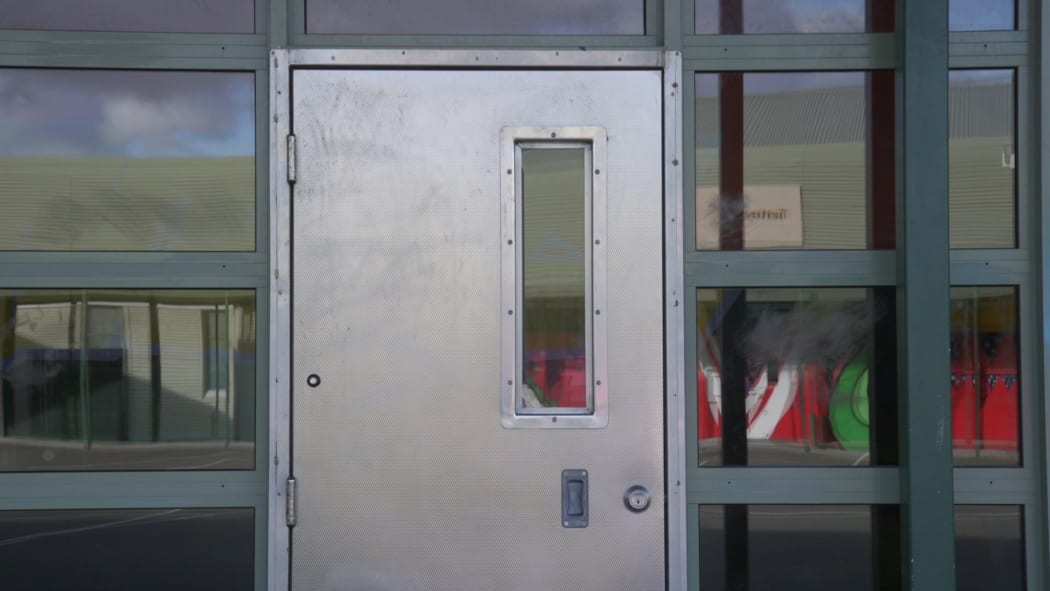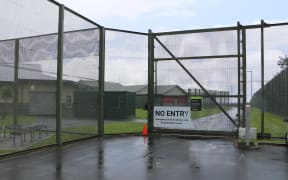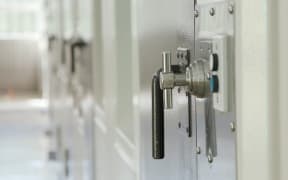A report obtained by RNZ has laid bare a litany of failures during the escape of two offenders from a youth justice residence in 2020.

Inside a youth justice residence (file image). Photo: RNZ / Cole Eastham-Farrelly
At the time both boys were detained for serious offences.
The report by Oranga Tamariki outlined how mis-steps by staff allowed the pair to sneak out of a North Island residence undetected and spend days on the run.
The story begins at 7.50pm on an evening in 2020.
It is bedtime at the residence. All of the 29 boys residing there have finished their shower routines and are heading for their rooms.
The first escapee walks down a corridor - unescorted - to to his bedroom. He scans his surroundings before making a dash to a second bedroom.
The second escapee then makes his way down the corridor - unescorted - before also entering his bedroom. Staff do not notice the pair are together.
At 8.11 pm CCTV captures the pair running from their unit. They escape through the car park.
Sections of the report describing the actual escape are redacted, so it is not stated how the boys managed to break out of the room.
Eight minutes later the pair are caught again on CCTV from a local business casually walking down the road which leads to the residence.
At 9.31pm a room check is completed by a staff member, who initially does not find anything unusual. However, they quickly realise the boys are not in their rooms.
By this time, the pair have been out for about 80-90 minutes. Phone calls to police are made at 10.07 pm, and later the site acting manager is also called.
The fire service arrive at midnight on to help search the roofs. At 2am the next morning a review of CCTV footage establishes the boys are no longer on site.
Until this point, staff have been sure the pair are somewhere on the grounds of the residence.
It has been some 5 hours and 45 minutes since they escaped.
What went wrong?
Between the time the bedroom routine started and the first room check occurred there was a gap of roughly 1 hour and 40 minutes.
Oranga Tamariki Youth Justice Systems director Phil Dinham said room checks should take place every 15 minutes.
If a young person had gone to bed distressed this could be shortened to every five minutes.
The report also said staff had failed to follow operating procedures in that young people were able to congregate and move around unsupervised in the bedroom corridor.
Dinham said the main concern of the investigation was the time it took between the escape, staff realising the boys were not in their rooms, and establishing they were no longer on site.
Alongside the failure to do room checks, staff had spent too long searching the grounds and escalating the situation internally, he said.
Staff should have immediately escalated the situation to one of the boys possibly being outside the residence.
"As soon as there was a risk that they were not contained, not confined, then that should have been notified to the duty residence manager," Dinham said.
"Then he or her would have made the judgement call about whether to alert police at that point."
The report noted there had been technical difficulties accessing the site CCTV footage, and that the first timeline provided by staff to the acting manager had to be revised.
It meant a full review of the footage, with the new timeline took place at 2am.
The Oranga Tamariki report also found there had been signs the pair were planning an escape, but these were missed by staff.
Dinham said he understood the first indicator related to the two boys who had earlier been spotted whispering to each other.
"In retrospect that whispering could've been planning and plotting but at the time I think [staff thought] 'young people will whisper'.
"With hindsight it's 'Ah that's when they started the plotting', but at the time it was just two boys whispering."
The second indicator was that other boys from the unit had been seen on CCTV walking past the escapees rooms, noticing they were not there, and laughing, Dinham said.
However, at the time, this could have been misinterpreted as the boys simply laughing at someone inside the room pulling a rude gesture.
Dinham said all staff went through induction training and were walked through operating procedures covering all ranges of scenarios including escapes.
It was why "employment-related discussions" had taken place with staff alongside the investigation.
Dinham did not confirm if anyone had lots their job, but said specialist training had been put in place for staff who remained on site.
Changes had also been made to the senior management structure at the residence
What else has changed at the residence?
Accountability, Dinham said.
"We're making sure that staff, at whatever level, are accountable. They have a leadership role. It's not just the manager that has to lead," he said.
"Every staff member who is interacting with boys held in the residence has an accountability for their safety and wellbeing."
When incidents like this did happen, Dinham said Oranga Tamariki would group up management staff from all residences throughout New Zealand for a debrief.
It meant staff would learn from the incident and prevent it from happening elsewhere, he said.
When it came to security, there were challenges given youth justice residences were deliberately not built like prisons.
"We try to make them more like a place of rehabilitation than a place of incarceration, but we try to make them as secure as possible," Dinham said.
"Sometimes things will happen like we understand that maybe access to the roof from a particular point is easier than we thought so we've improved the ways of stopping access to the roof.
"Most escapes involve either young people getting hold of keys and then just unlocking doors and getting out or they involve getting onto the roof and using access to the roof as a way of accessing the perimeter fence.
"So we always review the physical infrastructure of the residence and whether we can improve that. All our residences are regularly undergoing refurbishments and improvements to their security."
Dinham said Oranga Tamariki was there for the young people in youth justice residences, and wanted to see them succeed and rehabilitate.
He also said the agency had a duty to keep staff and the public safe.
Whenever incidents occurred, whether it was an escape, assault, or harm incident, the youth justice team would always seek to learn and improve from that.
"We are very conscious that we hold those three duties very seriously. Rehabilitation of the young person, safety of the public and safety of our staff."







